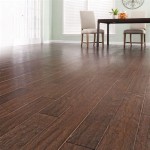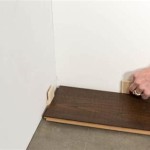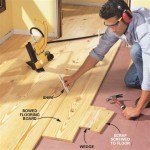Laminate Wood Flooring In The Kitchen: A Comprehensive Guide
The kitchen, often considered the heart of the home, is a space characterized by high traffic, spills, temperature fluctuations, and demanding cleaning regimes. Choosing flooring for this area requires careful consideration of durability, water resistance, ease of maintenance, and aesthetic appeal. While traditional kitchen flooring options include tile, vinyl, and hardwood, laminate wood flooring has emerged as a popular alternative. This article examines the suitability of laminate wood flooring for kitchens, discussing its advantages, disadvantages, installation considerations, and maintenance requirements.
Laminate flooring is a multi-layered synthetic product constructed from a high-density fiberboard (HDF) core, topped with a decorative photographic layer that mimics the appearance of wood. This photographic layer is then covered with a transparent wear layer, providing resistance to scratches, stains, and fading. The appeal of laminate flooring stems from its affordability, ease of installation, diverse aesthetic options, and relatively low maintenance requirements. However, its performance in a moisture-prone environment like a kitchen necessitates a thorough evaluation.
Understanding Laminate Flooring Construction and Its Impact on Kitchen Use
The construction of laminate flooring significantly affects its performance in the kitchen. The HDF core, while offering stability and structural integrity, is susceptible to water damage. When exposed to standing water or prolonged moisture, the HDF core can swell, warp, and delaminate. This damage is often irreversible and necessitates replacement of the affected flooring sections. Therefore, the water resistance of the laminate flooring, which is primarily determined by the quality of the wear layer and the tightness of the seams between planks, is a critical factor in its suitability for kitchen use.
The wear layer is rated according to the Abrasion Class (AC) scale, ranging from AC1 to AC5. Higher AC ratings indicate greater resistance to abrasion and wear. For kitchen applications, an AC3 or AC4 rating is generally recommended to withstand the high foot traffic and potential for spills and scratches. Choosing a laminate floor with a higher AC rating will contribute to its longevity and maintain its aesthetic appeal for a longer period.
The installation method also plays a crucial role in preventing water damage. Laminate flooring is typically installed as a floating floor, meaning it is not directly glued or nailed to the subfloor. Instead, the planks are joined together using a tongue-and-groove locking system. While this simplifies installation, it also creates seams that can allow water to seep through if not properly sealed. Using a moisture-resistant underlayment and carefully sealing the perimeter of the floor can help mitigate this risk.
Furthermore, the quality of the manufacturing process influences the water resistance of the laminate flooring. Higher-quality laminates often have a more tightly sealed wear layer and a denser HDF core, making them less prone to water damage. Consequently, investing in reputable brands that adhere to stringent quality control standards is essential for ensuring the longevity of laminate flooring in a kitchen environment.
Advantages of Using Laminate Wood Flooring in the Kitchen
Despite the moisture concerns, laminate flooring offers several advantages that make it an attractive option for kitchens. One of the primary benefits is its cost-effectiveness. Laminate flooring is typically significantly less expensive than hardwood or tile, making it a budget-friendly choice for homeowners. This affordability allows for a complete kitchen floor renovation without incurring excessive expenses.
Another advantage is the ease of installation. Laminate flooring's click-lock system allows for DIY installation, saving on professional installation costs. This feature is particularly appealing to homeowners who enjoy home improvement projects and are comfortable with basic carpentry skills. However, proper preparation of the subfloor and accurate alignment of the planks are crucial for a successful installation and to prevent issues such as uneven surfaces or gaps between planks.
Laminate flooring also offers a wide range of aesthetic options. The photographic layer can mimic the appearance of various wood species, colors, and textures, allowing homeowners to achieve the desired look without the higher cost and maintenance requirements of real hardwood. Furthermore, laminate flooring is resistant to fading and staining, ensuring that the floor retains its original appearance for a longer period. This is particularly important in a kitchen, where exposure to sunlight and spills is common.
Furthermore, laminate flooring is relatively easy to clean and maintain. Regular sweeping and mopping with a damp cloth are typically sufficient to remove dirt and spills. Unlike hardwood, laminate flooring does not require waxing or polishing. However, it is important to avoid using excessive water when mopping, as this can seep into the seams and damage the HDF core. Using a pH-neutral cleaner specifically designed for laminate flooring is also recommended to prevent damage to the wear layer.
Mitigating Moisture Risks and Ensuring Longevity of Laminate Flooring in the Kitchen
The key to successfully using laminate flooring in the kitchen lies in mitigating the risks associated with moisture exposure. Several strategies can be employed to minimize the potential for water damage and ensure the longevity of the floor. One of the most important steps is to choose a water-resistant or waterproof laminate flooring option. These products are designed with a tighter seam system and a more durable wear layer that provides enhanced protection against moisture penetration. Look for products labeled as "water-resistant" or "waterproof," and carefully review the manufacturer's specifications to understand the level of protection offered.
Proper installation is also crucial. The subfloor must be level, clean, and dry before installing the laminate flooring. Any imperfections in the subfloor can lead to uneven surfaces and gaps between planks, increasing the risk of water damage. Using a moisture-resistant underlayment is also essential. This underlayment acts as a barrier between the subfloor and the laminate flooring, preventing moisture from seeping up and damaging the HDF core. Carefully seal the perimeter of the floor with a waterproof sealant to prevent water from entering from the edges.
Regular maintenance is also important. Clean up spills immediately to prevent water from seeping into the seams. Avoid using excessive water when mopping, and always wipe up any excess water after cleaning. Use mats or rugs in high-traffic areas and near sinks and dishwashers to protect the flooring from scratches and spills. Regularly inspect the flooring for any signs of damage, such as swelling, warping, or delamination, and address any issues promptly. Replacing damaged planks can prevent further water damage and extend the life of the floor.
Finally, consider the layout of the kitchen and the potential for water exposure in different areas. For example, areas near sinks, dishwashers, and refrigerators are more prone to spills and leaks. In these areas, it may be prudent to consider using a more water-resistant flooring option, such as tile or vinyl, or to take extra precautions to protect the laminate flooring. Regularly checking for leaks and addressing any plumbing issues promptly can also help prevent water damage to the floor.

Kitchen Laminate Flooring 2024 Guide Floorvenue

Kitchen Laminate Flooring Choosing The Right Floor For Your

Laminate Flooring Ct Wood Dalene Carpet Onedalene

Laminate Flooring In The Kitchen

20 Gorgeous Examples Of Wood Laminate Flooring For Your Kitchen White Design Floor Timeless

Hot Flooring For Kitchens Is Wood But What About Water The Seattle Times

Light Wood Looking Laminate Kitchen Floor Flooring In Wooden

Hardwood Floors In The Kitchen Yes 1 6 Wood

Types Of Laminate Flooring The Home Depot

13 Ideas For Upgrading Your Kitchen Floors Extra Space Storage
Related Posts








